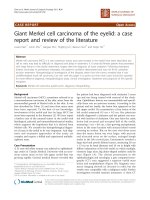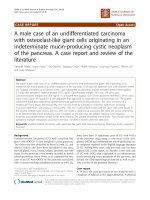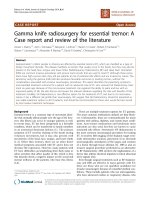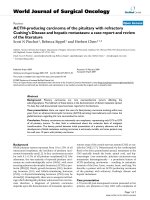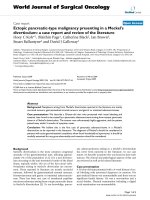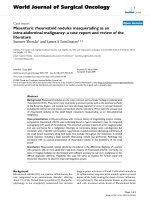báo cáo khoa học: "Liver metastasis originating from colorectal cancer with macroscopic portal vein tumor thrombosis: a case report and review of the literature" potx
Bạn đang xem bản rút gọn của tài liệu. Xem và tải ngay bản đầy đủ của tài liệu tại đây (687.67 KB, 5 trang )
CASE REPO R T Open Access
Liver metastasis originating from colorectal
cancer with macroscopic portal vein tumor
thrombosis: a case report and review of the
literature
Yoshito Tomimaru
1,2
, Yo Sasaki
3*
, Terumasa Yamada
1
, Kunihito Gotoh
1
, Shingo Noura
1
, Hidetoshi Eguchi
1,2
,
Isao Miyashiro
1
, Masayuki Ohue
1
, Hiroaki Ohigashi
1
, Masahiko Yano
1
, Osamu Ishikawa
1
, Shingi Imaoka
1
Abstract
Introduction: Macroscopic tumor thrombi occupying the main portal branch are rarely seen in patients with liver
metastasis.
Case presentation: A 55-year-old Japanese man who had previously undergone surgery for adenocarcinoma of
the ascending colon presented with a metastatic liver tumor accompanied by a macroscopic tumor thrombus in
the right portal branch. Right lobectomy and removal of the tumor thrombus were performed, and the liver
metastasis and tumor thrombus were successfully resected. Histopathological examination of the liver tumor
revealed adenocarcinoma, consistent with that of the previous colon cancer, confirming that the liver tumor was a
metastasis from the colon cancer. Our patient remains well without recurrence at 51 months after the liver surgery.
Conclusion: The prognosis of patients with liver metastasis accompanied by a portal vein tumor thrombus
remains unknown, but, considering several previous reported cases together with our case report, a better
prognosis may be expected if the tumor is successfully removed by anatomical liver resection.
Introduction
Portal vein tumor thrombosis (PVTT) is associated with
hepatocellular carcinoma (HCC), with a reported inci-
dence of PVTT of 30% to 70% [1-3]. A recent pathologi-
cal study of metastatic liver cancer originating from
colorectal cancer found microscopic tumor invasion in
the intra-hepatic portal vein to be a relatively common
finding in addition to HCC [4,5]. Howev er, macroscopic
tumor thrombi occupying the main p ortal branch are
rare in patients with liver metastasis [6,7], including that
from colorectal cancer (Table 1) [8-14].
We report on a case of liver metastasis from colon
cancer with macroscopic tumor thrombi in the right
portal branch. Herein, we describe the case and review
the literature for liver metastases from colorectal cancer
accompanied by macroscopic portal vein tumor
thrombi.
Case presentation
A 55-year-old Japanese man underwent a right hemico-
lectomy in our hospital for a tumor in the ascending
colon He did not have any inherited or acquired throm-
bophilic predispositions. The tumor was histopathologi-
cally diagnosed as moderately differentiated
adenocarcinoma, and staged as IIIB (T4N1M0), accord-
ing to the TNM (tumor, nodes, metastasis) classification
[15]. Tumor markers including carcinoembryonic antigen
(CEA) and carbohydrate antigen 19-9 (CA19-9) were all
within normal limits before the operation. During follow-
up in our outpatient clinic, our patient received ad juvant
systemic chemotherapy for six months.
Despite the adjuvant treatment, abdominal computed
tomography (CT) 13 months after surgery showed a
liver tumor in segment 8 based on Couinaud’s classifica-
tion [16]. Our patient was subsequently readmitted to
* Correspondence:
3
Department of Surgery, Yao Municipal Hospital, Osaka, Japan
Full list of author information is available at the end of the article
Tomimaru et al. Journal of Medical Case Reports 2010, 4:382
/>JOURNAL OF MEDICAL
CASE REPORTS
© 2010 Tomimaru et al; licensee BioMed Central Ltd. Thi s is an Open Access article dist ributed under the terms of the Creative
Commons Attribution License ( nses/by/2.0), which permits unrestricted use, distribution, and
reproduction in any me dium, provided the original work is properly cited.
Table 1 Previously reported cases with macroscopic portal vein thrombus (PVTT) from successfully resected colorectal cancers
Case
no.
Reference Age
and
gender
Synchronous
or
metachronous
Location of
primary
tumor
Histology Stage Interval from colorectal
resection to diagnosis of
PVTT, months
Size of liver
metastasis,
mm
Location of
liver
metastasis
Location
of PVTT
Survival after
removal of PVTT,
months
Prognosis
1 Tanaka
et al. [8]
59/M Synchronous Sigmoid Mod T3N1 - Unknown S8, left Left PV 11 Alive,
recurrence
2 Tanaka
et al. [8]
54/M Metachronous Rectum Mod T4N2 12 70 S2/3 Left PV 21 Alive, no
recurrence
3 Tanaka
et al. [8]
60/M Metachronous Transverse Poor T3N2 4 25 S7 Right PV 31 Alive, no
recurrence
4 Tanaka
et al. [8]
63/F Metachronous Sigmoid Well T3N0 47 55 S6 Posterior
PV
55 Alive, no
recurrence
5 Tanaka
et al. [8]
62/F Metachronous Descending Mod T3N1 11 - - Right PV 102 Alive, no
recurrence
6 Lee
et al. [10]
28/M Synchronous Sigmoid Muc Unknown
(N+)
- 40 S2/3 Left PV
branch
1.5 Alive,
recurrence
7 Sugiura
et al. [11]
39/F Metachronous Transverse,
rectum
Well Unknown 141 Unknown
(huge)
S4/5/6/7/8 Left PV 24 Alive, no
recurrence
8 Urahashi
et al. [12]
57/M Metachronous Transverse Mod T3N1 < 24 40 S6/7 Main PV 11 Died,
recurrence
9 Urahashi
et al. [12]
51/M Metachronous Transverse Mod T3N2 < 24 145 S7/8 Anterior
PV
9 Died,
recurrence
10 Urahashi
et al. [12]
54/M Metachronous Rectum Well T3N2 < 24 35 S3 Left PV 36 Died,
recurrence
11 Urahashi
et al. [12]
70/F Metachronous Ascending Mod T3N1 < 24 - - Main PV 6 Died,
recurrence
12 Urahashi
et al. [12]
45/F Metachronous Descending Mod T3N2 < 24 60 S5, S6, S8 Main PV 10 Died,
recurrence
13 Oikawa
et al. [13]
55/F Synchronous Rectosigmoid Muc T3N1 - 100 S6/7, left Posterior
PV
9 Died,
recurrence
14 Matsumoto
et al. [14]
58/M Metachronous Rectosigmoid Mod T3N0 6 - - Left PV 66 Alive, no
recurrence
15 Present
case
55/F Metachronous Ascending Mod T4N1 13 28 S8 Right PV 51 Alive, no
recurrence
Mod = moderately differentiated adenocarcinoma; poor = poorly differentiated adenocarcinoma; PV = portal vein; PVTT = portal vein tumor thrombosis; well = well differentiated adenocarcinoma; muc = mucinous
adenocarcinoma.
Tomimaru et al. Journal of Medical Case Reports 2010, 4:382
/>Page 2 of 5
our hospital for full diagnosis and treat ment of the liver
tumor. Hepatitis B surface antigen, hepatitis B core anti-
body, and hepatitis C antibody test results w ere nega-
tive. Tumor markers including CEA, CA19-9,
a-fetoprotein, and protein induced by vitamin K absence
or antagonist II, were all within normal limits. CT arter-
iography (CTA) showed a tumor of approximately 25
mm in diameter consisting of two components: an
apparently solid part and a cystic component. The solid
component of the tumor was enhanced in the early
phase of the CTA and was washed out in the delayed
phase, a pattern compatible with HCC (Figure 1A).
However, based on the cystic component, the t umor
was also suspected to be a cystadenocarcinoma. The
right portal vein was not visible on portography, but CT
during arterial portography (CTAP) revealed defective
portal perfusion in the whole right lobe of the liver (Fig-
ure 1C). This finding was suggestive of PVTT. Endo-
scopic retrograde cholangiography was performed to
differentiate cystadenocarcinoma connected to a biliary
duct. However, no specific findings of biliary carcinoma
were noted and the collected bile sample was cytologi-
cally negative. For preoperative differential diagnosis of
the tumor, echo-guided biopsy was performed. The
biopsy revealed that the liver tumor was a liver metasta-
sis from the colon cancer. With a preoperative diagnosis
of liver metastasis from colon cancer, laparotomy was
performed. Neither peritoneal dissemination nor hilar
lymph node metastasis was detected. The liver tumor,
measuring 28 × 25 mm in size, was located in segment
8, while PVTT was located in the right portal vein in
direct communication with the liver tumor. Our patient
underwent a right lobectomy (Figure 2A). The resected
tumor, which had a fibrotic capsule, macroscopically
resembled HCC. The cystic component observed on
preoperative examination was not detected in the
resected specimen. Histopathology of the resected liver
tumor and PVTT revealed a moderately differentiated
adenocar cinoma (Figure 2B). The histopathological find-
ings from the resected tumor were similar to the pre-
viously resected ascending colon cancer. Based on the
similarity, the final diagnosis for the liver tumor was a
liver metastasis from the ascending colon cancer accom-
panied by macroscopic PVTT in the right portal branch.
Histopathological infiltration into the endothelial layer
of the portal vein was not seen. All resected margins
were free from cancer. Postoperatively, our patient
agreed to receive adjuvant chemotherapy. Our patient
remains healthy, with no evidence of recurrence 51
months after the hepatectomy.
Discussion
Microscopic tumor invasion into the intra-hepatic portal
vein is detected in about 20% of cases with liver metas-
tasis from colorectal cance r [4]. However, our review of
previously reported cases revealed few instances of
PVTT in the main portal branch [8-14]. In fact, the
report ed incidence of macroscopic PVTT similar to that
observed in our case report is 2.8% (4 of 142) [9]. From
January 1990 to December 2008, 231 patients underwent
resection of liver metastases from primary colorectal
cancer in our hospital. Of these patients, only our
patient’s case showed macroscopic PVTT (0.4%).
Macroscopic examination of the resected tumor in our
patient did not sho w the preo peratively detected cystic
component of the tumor. It is possible that necrotic
fluid, having filled the cystic component, was absorbed
ab
c
Figure 1 Computed tomography arteriography (CTA) of the
liver tumor in the early phase (A) and the delayed phase (B).
C) Computed tomography during arterial portography (CTAP)
showing a portal vein tumor thrombus (arrow) and a perfusion
defect in the entire right lobe.
a b
c
Figure 2 A) Macroscopic view of the resected liver including
the metastatic liver tumor (arrowheads) and the tumor
thrombus in the right portal vein (arrows). Histopathological
findings of the metastatic liver tumor (B) and primary colon cancer
(C) showing moderately differentiated adenocarcinoma.
Tomimaru et al. Journal of Medical Case Reports 2010, 4:382
/>Page 3 of 5
and thus replaced by the tumor before removal. The
resected liver tumor and PVTT macroscopically
resembled H CC, which commonly develops tumor
thrombi and expansive growth in the portal vein and in
the hepatic vein [17]. The capsule formation of HCC is
possibly the result of mechanical compression or high
inner pressure from the expansive tumor growth, thus it
is also feasible that tumor thrombi might extend into
the portal vein via a pressure gradient mechanism [18].
In contrast, liver metastases from colorectal cancer are
generally less commonly surrounded by a capsule com-
pared to HCC, with one study detecting encapsulated
liver metastases from colorectal cancer in only 20% of
cases [19]. The resected tumor in our patient, which
was encapsulated, also resembled HCC in this point of
the capsule formation. This resemblance to HCC may
suggest that the PVTT in this ca se might have also
expanded into the portal vein thro ugh a pressure gradi-
ent mechanism, as in HCC.
Table 1 summarizes 15 reported cases of liver metas-
tasis from colorectal cancer with macroscopic PVTT,
including our patient. No specific clinical f eatures typi-
fied patients with colorectal liver metastasis and PVTT
with respect to age, gender, ortheprimarytumorsite.
With regard to the stage of the primary colorectal can-
cer, all the primary colorectal lesions recorded were
divided into T3 or T4 according to the TNM classifica-
tion [15], and lymph no de metastasis was found in most
of the cases (12 of 14, 86%). In 12 of the 15 cases (80%),
liver metastasis was accompanied by PVTT, and the
liver tumor was relatively large (60 ± 37 mm; range, 25
to 145 mm). PVTT was found metachronously in 12
patients, and synchronously with the primary tumor in
the remaining three patients. Although Matsumoto et
al. [14] suggested that survival after the operation of
PVTT from colorectal cancer might depend on whether
the PVTT had developed synchronously or metachro-
nously, this s uggestion seems not to be applied to the
review in the present study. With regards to the liver
tumor, anatomical liver resection was performed in all
15 patients. The one-year, three-year and five-year over-
all survival rates in the 15 cases after operation for
PVTT were 64.3%, 51.4%, and 51.4%, respectively. Since
this analysis was performed only in a limited number of
patients, specifically successful cases, the analysis did
not allow a precise general prognosis to be determined
for metastatic liver tumor with PVTT. Howev er, even if
the aforementioned success bias was taken into consid-
eration, this outcome seems to be relatively good. In
general, anatomical liver resection is not usually
employed for colorectal liver metastasis in contrast to
HCC [20-22]. However, considering that colorectal liver
metastasis with PVTT is likely to spread along the por-
tal tributaries as in HCC, it may be speculated that
anatomical liver resection, which is suitable for such
liver metastasis, contributes to the favorable prognosis
for colorectal liver metastasis with PVTT, as suggested
by some investigators [9,10,14]. Today, some treatment
options for colorectal liver metastasis have been estab-
lished inc luding surgery, ablation therapy, hepatic arter-
ial infusion chemotherapy, and systemic chemotherapy,
but there is no consensus for the treatment for colorec-
tal liver metastasis accompanying PVTT. This successful
case is not enough to conclude that surgery is the best
treatment option for such liver metastasis, but we sug-
gest at least that macrosc opic PVTT is not a contraindi-
cation to liver surgery.
Conclusion
Our patient had a successfully resected liver metastasis
from colorectal cancer with macroscopic P VTT. The
prognosis of patients with such PVTT remains unclear,
but from previous reports it would appear a better prog-
nosis can be expected if the tumor is successfully
resected by anatomical liver resection.
Consent
Written informed consent was obtained from the patient
for publication of this case report and any accompany-
ing images. A copy of the written consent is available
for review by the Editor-in-Chief of this journal.
Author details
1
Department of Surgery, Osaka Medical Center for Cancer and Cardiovascular
Diseases, Osaka, Japan.
2
Department of Surgery, Graduate School of
Medicine, Osaka University, Osaka, Japan.
3
Department of Surgery, Yao
Municipal Hospital, Osaka, Japan.
Authors’ contributions
YT researched the case, reviewed the literature, and was a major contributor
to preparation of the manuscript. YS was responsible for the research and
review. TY, KG, SN, HE, IM, and MO supported the preparation of the
manuscript. HO, MY, OI, and SI prepared the final version of the manuscript.
All the authors read and approved the final manuscript.
Competing interests
The authors declare that they have no competing interests.
Received: 6 April 2010 Accepted: 26 November 2010
Published: 26 November 2010
References
1. Albacete RA, Matthews MJ, Saini N: Portal vein thromboses in malignant
hepatoma. Ann Intern Med 1967, 67:337-348.
2. Subramanyam BR, Balthazar EJ, Hilton S, Lefleur RS, Horii SC,
Raghavendra BN: Hepatocellular carcinoma with venous invasion.
Sonographic-angiographic correlation. Radiology 1984, 150:793-796.
3. Liver Cancer Study Group of Japan: Primary liver cancer in Japan.
Clinicopathologic features and results of surgical treatment. Ann Surg
1990, 211:277-287.
4. Yamamoto J, Sugihara K, Kosuge T, Takayama T, Shimada K, Yamasaki S,
Sakamoto M, Hirohashi S: Pathologic support for limited hepatectomy in
the treatment of liver metastases from colorectal cancer. Ann Surg 1995,
221:74-78.
Tomimaru et al. Journal of Medical Case Reports 2010, 4:382
/>Page 4 of 5
5. Shirabe K, Takenaka K, Gion T, Fujiwara Y, Shimada M, Yanaga K, Maeda T,
Kajiyama K, Sugimachi K: Analysis of prognostic risk factors in hepatic
resection for metastatic colorectal carcinoma with special reference to
the surgical margin. Br J Surg 1997, 84:1077-1080.
6. Atri M, de Stempel J, Bret PM, Illescas FF: Incidence of portal vein
thrombosis complicating liver metastasis as detected by duplex
ultrasound. J Ultrasound Med 1990, 9:285-289.
7. Otani T, Usui H, Tsunoda-Shimizu H, Takada Y, Takanishi K, Minami T:
A crescent-shaped sparing proximal to a liver tumor may indicate
underlying portal tumor thrombus. Hepatogastroenterology 2003,
50:1631-1633.
8. Tanaka A, Takeda R, Mukaihara S, Hayakawa K, Takasu K, Terajima H,
Yamaoka Y, Chiba T: Tumor thrombi in the portal vein system originating
from gastrointestinal tract cancer. J Gastroenterol 2002, 37:220-228.
9. Tada K, Kokudo N, Seki M, Ueno M, Azekura K, Ohta H, Yamaguchi T,
Matusbara T, Takahashi T, Nakajima T, Yanagisawa A, Muto T: Hepatic
resection for colorectal metastasis with macroscopic tumor thrombus in
the portal vein. World J Surg 2003, 27:299-303.
10. Lee KF, Chu W, Lai PB: Portal vein tumor thrombus in colorectal liver
metastasis. Am J Surg 2005, 190:364-365.
11. Sugiura T, Nagino M, Ebata T, Arai T, Oda K, Yuasa N, Nimura Y: Treatment
of colorectal liver metastasis with biliary and portal vein tumor thrombi
by hepatopancreatoduodenectomy. J Hepatobiliary Pancreat Surg 2006,
13:256-259.
12. Urahashi T, Yamamoto M, Ohtsubo T, Katsuragawa H, Katagiri S, Takasaki K:
Liver metastases with massive portal venous tumor thrombi from
colorectal cancer: can be treated by surgical resection?
Hepatogastroenterology 2007, 54:210-213.
13. Oikawa T, Takayama T, Okada S, Kamo T, Sugitani M, Sakamoto M:
Macroscopic portal vein tumor thrombi of liver metastasis from
colorectal cancer. J Hepatobiliary Pancreat Surg 2009, 16:90-93.
14. Matsumoto J, Kojima T, Hiraguchi E, Abe M: Portal vein tumor thrombus
from colorectal cancer with no definite metastatic nodules in liver
parenchyma. J Hepatobiliary Pancreat Surg 2009, 16:688-691.
15. Sobin LH, Wittekind C: UICC TNM Classification of Malignant Tumours. 5
edition. New York: Wiley; 1997, 66-69.
16. Couinaud C: Lobes et segments hepatiques. Press Med 1954, 62:709-712.
17. Nakashima T, Okuda K, Kojiro M, Jimi A, Yamaguchi R, Sakamoto K, Ikari T:
Pathology of hepatocellular carcinoma in Japan. 232 Consecutive cases
autopsied in ten years. Cancer 1983, 51:863-877.
18. Grigioni WF, D’Errico A, Biagini G, Mazziotti A, Bolondi L, Liotta LA,
Mancini AM, Garbisa S: The capsule surrounding primary liver tumors:
wherefrom its prognostic significance? Int J Cancer 1990, 45:637-643.
19. Lunevicius R, Nakanishi H, Ito S, Kozaki K, Kato T, Tatematsu M, Yasui K:
Clinicopathological significance of fibrotic capsule formation around
liver metastasis from colorectal cancer. J Cancer Res Clin Oncol
2001,
127:193-199.
20. Makuuchi M, Hasegawa H, Yamazaki S: Ultrasonically guided
subsegmentectomy. Surg Gynecol Obstet 1985, 165:346-350.
21. Minagawa M, Makuuchi M, Torzilli G, Takayama T, Kawasaki S, Kosuge T,
Yamamoto J, Imamura H: Extension of the frontiers of surgical indications
in the treatment of liver metastases from colorectal cancer: long-term
results. Ann Surg 2000, 231:487-499.
22. Kokudo N, Tada K, Seki M, Ohta H, Azekura K, Ueno M, Matsubara T,
Takahashi T, Nakajima T, Muto T: Anatomical major resection versus
nonanatomical limited resection for liver metastases from colorectal
carcinoma. Am J Surg 2001, 181:153-159.
doi:10.1186/1752-1947-4-382
Cite this article as: Tomimaru et al.: Liver metastasis originating from
colorectal cancer with macroscopic portal vein tumor thrombosis: a
case report and review of the literature. Journal of Medical Case Reports
2010 4:382.
Submit your next manuscript to BioMed Central
and take full advantage of:
• Convenient online submission
• Thorough peer review
• No space constraints or color figure charges
• Immediate publication on acceptance
• Inclusion in PubMed, CAS, Scopus and Google Scholar
• Research which is freely available for redistribution
Submit your manuscript at
www.biomedcentral.com/submit
Tomimaru et al. Journal of Medical Case Reports 2010, 4:382
/>Page 5 of 5

